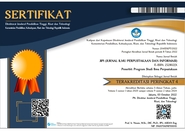Tren Masif Internet of Things (IOT) di Perpustakaan
Abstract
Topik paper ini adalah Internet of Things (IOT) khususnya di perpustakaan. Penulis menguraikan definisi dan konsep IOT, pentingnya IOT dari perpustakaan, dan aplikasi potensial dari IOT untuk perpustakaan. Sumber referensi yang digunakan oleh penulis adalah dari artikel jurnal, buku, materi presentasi, dan situs manajemen data laboratorium. IOT menjadi tren penting bagi perpustakaan karena dapat mempermudah peningkatan kualitas layanan, fasilitas, dan penghematan biaya untuk mengakses informasi secara online oleh pengguna dan pustakawan. Misalnya dalam penggunaan di museum luar negeri sebagai layanan online, kontrol lampu bangunan, smart campus dan penyimpanan cloud computing di Perpustakaan.
The topic of this paper is the Internet of Things (IOT) especially in the library. The author outlines the definitions and concepts of IOT, the importance of IOT from libraries, and potential applications of IOT for libraries. The reference sources used by the author are from journal articles, books, presentation materials, and laboratory data management sites. IOT becomes an important trend for libraries because itcan facilitate the improvement of servicequality, facilities, and cost savings to access information online by users and librarians. For example in use in overseas museums as online services, building light controls and cloud computing storage in the Library
Keywords
Full Text:
PDFReferences
Adafruit. 2009. Photocells a.k.a CdS cells, photoresistors, LDR (light dependent resistor). Retrieved November 4 2017, from http://adafruit.com.
Alghamdi, Abdullah and Sachin Shetty. 2016. Survey: Toward A Smart Campus Using the Internet of Things. IEEE 4th International Conference on Future Internet of Things and Cloud. Retrieved Desember 2 2017, from http://www.FiCloud.
Atzori, Luigi, Antonio Iera, and Giacomo Morabito. 2010. ”The internet of things: A survey.” Computer networks, 2787-2805.
Barner, Keren. 2011. The Library is a Growing Organism: Ranganathan's Fifth Law of Library Science and the Academic Library in the Digital Era. Library Philosophy and Practice (e-journal), 548. Retrieved November 8 2017, from http://digitalcommons.unl.edu.
Cheng, Y.-Q. 2010. Eksplorasi Smart Cam-nanah dari Universitas Zhejiang. Retrieved Desember 2 2017, from http://wenku.baidu.com.
Evans, Dave. 2011. The Internet of Things How the Next Evolution of the Internet
Is Changing Everything. Retrieved November 10 2017, from http://Cisco IBSG.com.
Evans, Woody. (2009). Building Library 3.0: Issues in Creating a Culture of Participation. Oxford, UK: Chandos Publishing.
Fadhilatul, H. 2014. Penerapan RFID (Radio Frequency Identification) di perpustakaan. Jurnal Ilmu Perpustakaan & Kearsipan Khizanah Al-Hikmah, 2 (1),71-79.
Finkenzeller, Haus. 2003. RFID Handbook: Fundamentals and Applications in contaccless smartcard, Radio Frequency Identification and Near-field Communicatio (thrid edition). United Kindom: Wiley.
Guo, Min And Yu Zhan. 2016. The Research of Smart Campus Based on Internet of Things & Cloud Computing. Retrieved December 2, 2017, from http: www.google.com.
M. Dohler, I. Vilajosana, X. Vilajosana, dan J. Llosa. 2011. Kota-kota pintar: Sebuah
rencana aksi. Proc. Barcelona Cerdas Kota Kongres, Barcelona, Spanyol, 16.
M. Wang and J. W. P. Ng. 2012. Intelligent Mobile Cloud Education: Smart Anytime-Anywhere Learning for the Next Generation Campus Environment. In 2012 8th International Conference on Intelligent Environments (IE), 149–156.
Ma, H. 2011. Thinking on Development and Construction of Campus Network of Next Step. Retrieved Desember 2 2017, from http://wenku.baidu.com.
Nag, Ashwini and Khaiser Nikam. 2016. Internet Of Things Applications In Academic Libraries. International Journal of Information Technology and Library Science, 5 (1), 1 -7. Retrieved November 8 2017, from http://www.ripublication.com.
OCLC. 2015. Libraries and the Internet of Things Next Space. Retrieved November 5 2017 from http://www.oclc.org.
Pujar, Shamprasad M. and K V Satyanarayana. 2015. Internet of Things and libraries. Journal Annals of Library and Information Studies, 62, 186-190.
S. Kusakabe, H. H. Lin, Y. Omori, and K. Araki. 2014. Requirements Development of Energy Management System for a Unit in Smart Campus. In 2014 IIAI 3rd International Conference on Advanced Applied Informatics (IIAIAAI), 405–410.
T. Anagnostopoulos, A. Zaslavsky, and A. Medvedev. 2015. Robust waste collection exploiting cost efficiency of IoT potentiality in Smart Cities. In 2015 International Conference on Recent Advances in Internet of Things (RIoT), 1-6.
T. Anagnostopoulos, A. Zaslavsy, A. Medvedev, and S. Khoruzhnicov. 2015. Top k Query Based Dynamic Scheduling for IoT-enabled Smart City Waste Collection. In 2015 16th IEEE International Conference on Mobile Data Management (MDM), 2, 50–55.
T. Robles, et-al. 2014. An Internet of Things-Based Model for Smart Water Management. In 2014 28th International Conference on Advanced Information Networking and Applications Workshops (WAINA), 821–826.
Yang, W. dan Liu, Y.-H. 2013.The Key Problem and Countermeasures in the Construction of Smart Campus in Colleges and Universities. Cina Journal of ICT dalam Pendidikan, 39-41.
Zhou, K. 2011. Shanghai Jiaotong University First “Wisdom Pan in the Classroom”. Chinese Youth Daily.
”iCampus,”. iCampus. Retrieved Desember 2 2017, from http://icampus.mit.edu.
DOI: http://dx.doi.org/10.30829/jipi.v4i2.4381
Refbacks
- There are currently no refbacks.
Copyright (c) 2019 Fitri Handayani

This work is licensed under a Creative Commons Attribution-ShareAlike 4.0 International License.










_1.png)
.png)
_.png)

